10 Namibia Bucket List Experiences
10 Namibia Bucket List Experiences
Namibia has been at the top of my bucket list for a long time. Earlier this year, I finally visited this amazing African country and it completely exceeded my expectations. It became my favourite trip ever! That’s why I want to share with you my list of 10 Namibia Bucket List Experiences. I will also share my itinerary and the way I organized my time in Namibia.
Namibia is a Southern African country with a huge Atlantic Ocean coast. It share borders with Angola, Botswana, Zambia, Zimbabwe and South Africa. The vastness of the territory and the diversity of the landscapes, makes it an extremely interesting country to visit. From sand deserts to grassland savanna, from rocky hills to woodland and wetland areas, from coastal dramatic landscapes to scenic mountains. Namibia has it all!
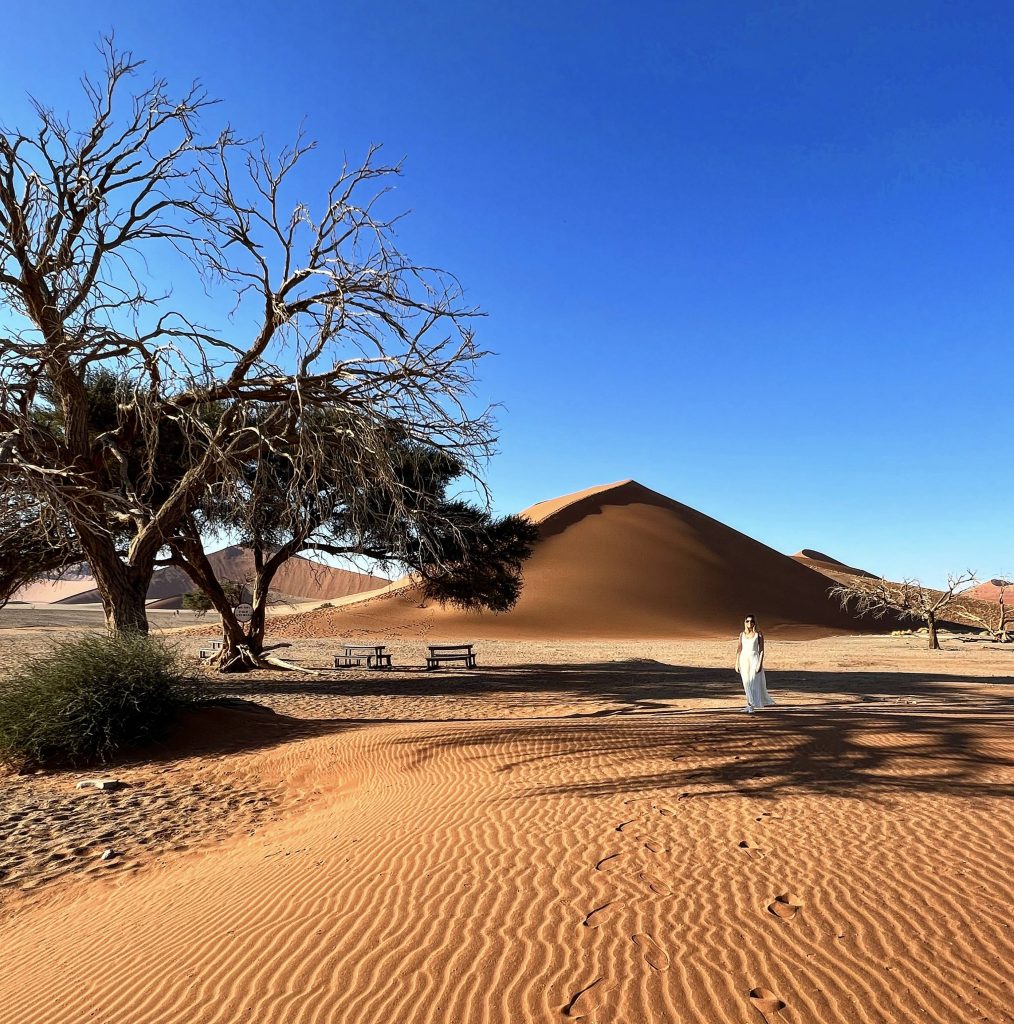
Because of its size, there are endless options of places to visit in the country. If you want to explore the different regions of Namibia, you will probably need at least two weeks to travel around.
As I only had around ten days, I had to do some difficult choices about where to go. So I decided to focus in 3 main areas. Namib-Naukluft Park in the Namib Desert, the coastal region of Swakopmund, Windhoek and the surrounding area to have a safari experience. I chose the places I wanted to visit the most and the experiences I could not miss in the limited time I had available. When planning a trip to Namibia, I recommend you do the same. Take some time researching about what this beautiful country has to offer and make your own itinerary based on your preferences and time.
When to go to Namibia? Namibia has several seasons, the rainy season from November to March, the dry season from June to August, and the shoulder seasons from September to October and from April to May.
Most of the people visit the country in the dry months, considered the best to viewing wildlife and with no rain at all. It’s important to be aware that in the dry season it can be very chilly (especially in the desert areas at night), because Namibia is located in the Southern Hemisphere and it’s winter time at that time.
I decided to visit Namibia in the shoulder season (second half of April) and it was a great option. I had warm weather, almost no rainfall (it just rained a bit a few hours in one day), and plenty of animals to view.
But how to travel around Namibia? Exploring Namibia means traveling hundreds or even thousands of kilometers to visit different locations spread around the country. Namibia territory is huge, places are far from each other and roads are sometimes rough and quite challenging to drive. So it’s really important to plan ahead your way around the country.
You can rent a car, that’s what most people people do. In that case it’s advisable to take a 4×4 vehicle and to do a good insurance. You can also join a group tour, there are plenty of options available. Or you can travel with a transfer service connecting the main locations of Namibia like Windhoek, Sossusvlei, Swakopmund, Etosha or Damaraland.
Namibia2GO is an amazing option to either rent a car or provide transfer services around those locations with great quality, at an affordable price. As I wanted to enjoy my trip to the fullest without being concerned about driving, I chose Namibia2GO transfer services and I couldn’t recommend it more.
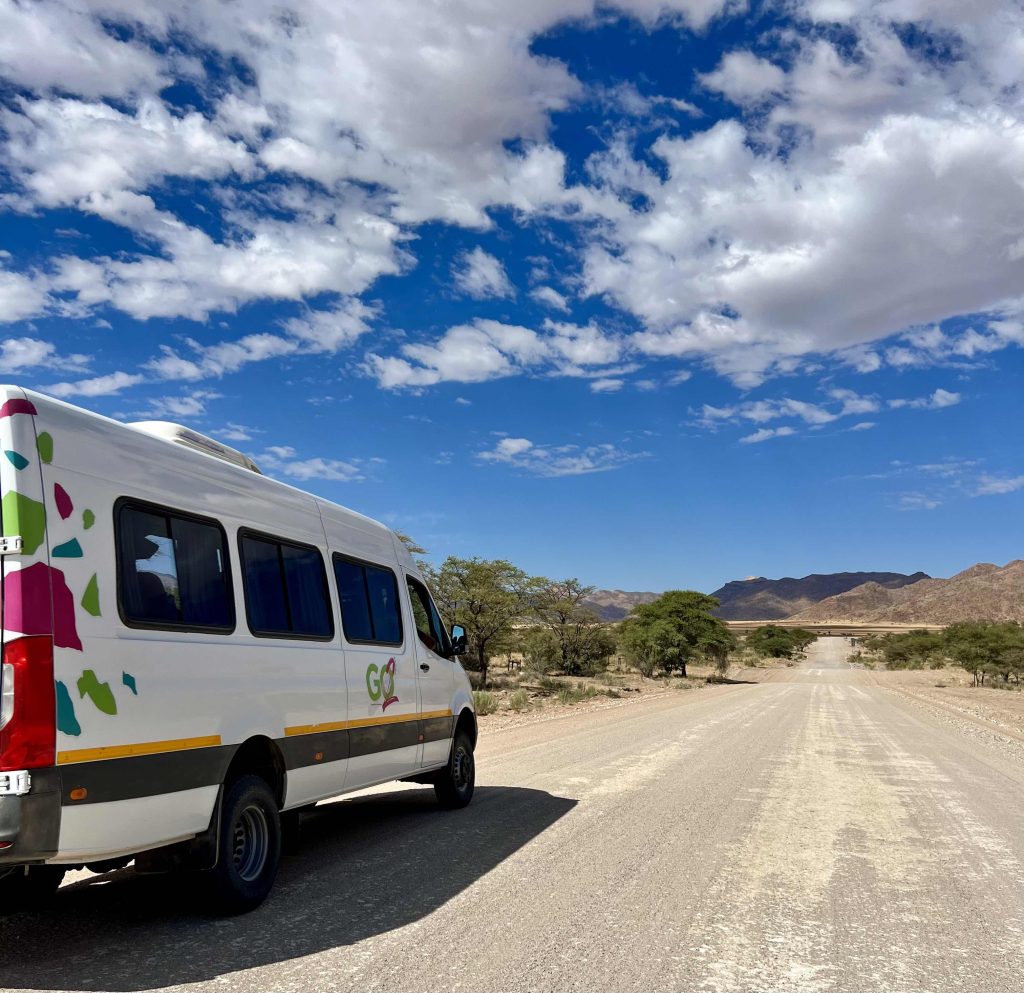
Where to stay in Namibia? That’s the other question I hear the most. There are many options available from beautiful design hotels, luxury retreats, to comfortable lodges and more rustic and adventurous camping offers. You can easily choose whatever fits within your preference and budget. I recommend to book your accommodation in advance because some places can get easily fully booked.
As I traveled around the country, I stayed in 6 different locations with the following itinerary.
Day 1 – Windhoek
Day 2 to 4 – Namib-Naukluft Park in the Namib Desert, including Solitaire, Sossusvlei and Deadvlei
Day 5 to 7 – Swakopmund and Walvis Bay in the Atlantic Coast of Namibia
Day 8 to 10 – Windhoek surrounding area with a safari and a breakfast with giraffes experience
In order to help you plan your dream trip to Namibia, I’m happy to share my 10 Namibia Bucket List Experiences, based on my trip to this country and my own personal experience. I hope you enjoy your time in Namibia as much as I did and you have the time of your life.
Visit Windhoek
The capital of Namibia is probably the starting point and the end of the trip for most visitors in the country. As the International Airport is located there, most likely you will fly in and out from Windhoek. So you can easily spend one day in Windhoek exploring the city, which is rich in historical places and cultural inheritance.
No visit to Windhoek is complete without visiting Christuskirche – Christ Church, at the heart of the city. This is the most famous landmark of Windhoek, a Lutheran Church that was built in the beginning of the 20th century. Constructed from local sandstone and merging Neo-Gothic with Art Nouveau styles, the building is quite remarkable, reminiscing of a gingerbread house.
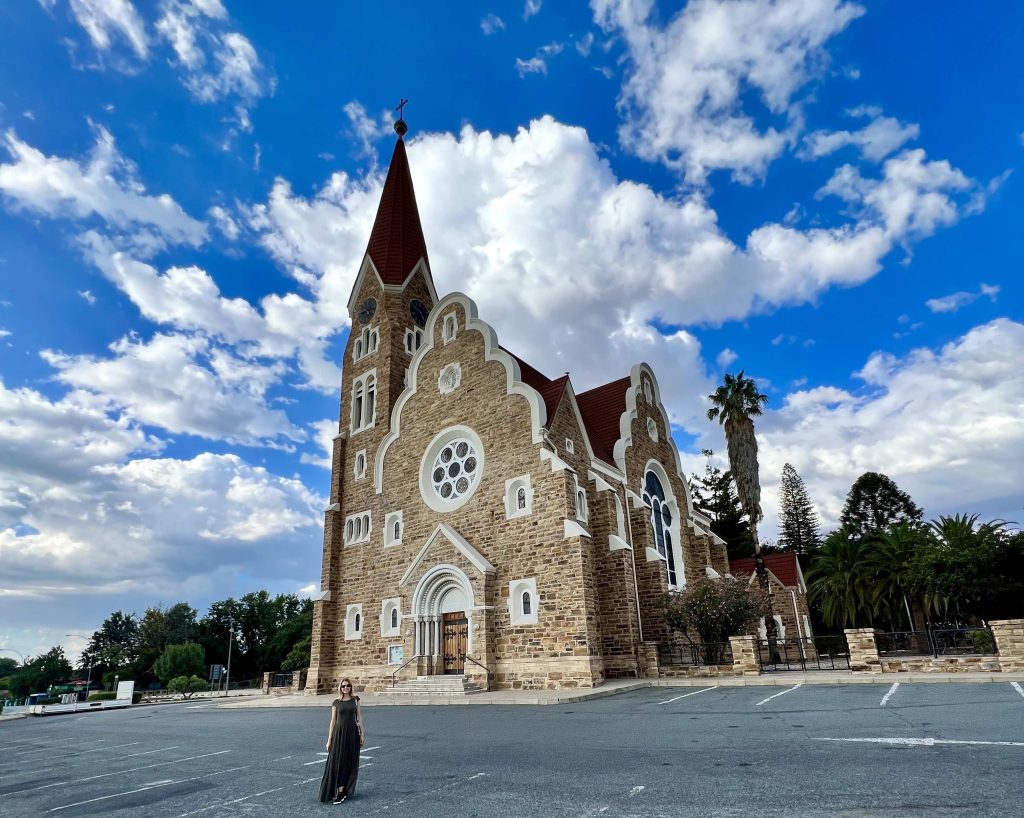
Around Christuskirche you can find Namibian Parliament building and the Museum Area, namely the National Museum of Namibia, located at an old fortress, and the Independence Memorial Museum.
To know more about the rich natural beauty of the country, you can also visit the National Botanic Garden of Namibia, showcasing the incredible diversity of indigenous flora.
If you plan to buy local art or authentic souvenirs, I recommend heading to Namibia Craft Centre, in the Old Breweries Complex. This is a covered market with more than 40 shops women-owned from rural communities, local projects and representing various ethnic groups. You will find in Namibia Craft Centre typical handicrafts, from carved tree roots to jewellery.
Last but nor least, you can taste a vast culinary offer in Windhoek, from typical gastronomy to international cuisine.
I stayed in Windhoek on my arrival to the country at The Weinberg Windhoek, a stylish hotel combining the old-world splendor of explorers with modern design. It is conveniently located near great restaurants of different culinary styles, a spa and a heritage building. At The Weinberg you can arrange a driver to take you to the city to see its many highlights, in case you don’t have your own rental car. From The Weinberg’s rooftop you have the best views to Windhoek, so just sit having a drink and watching the sun going down.
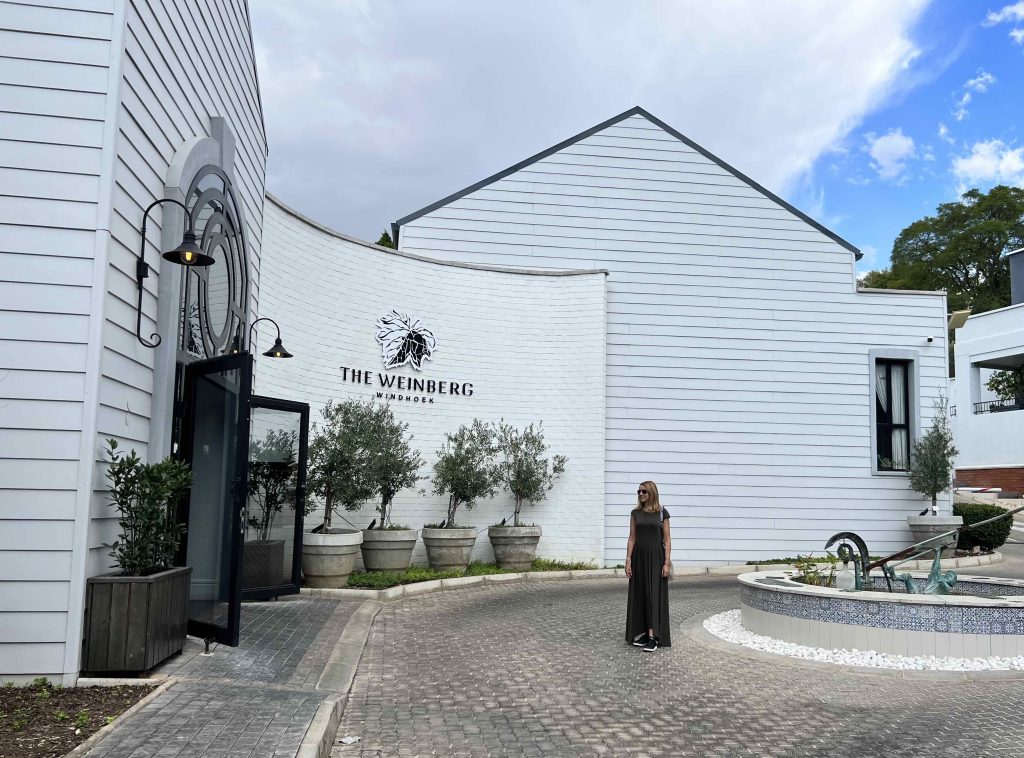
Embrace Namibia Endless Roads and Cross Iconic Landmarks
Roads in Namibia are vast, sometimes endless, quite often challenging and bumpy. But crossing the country by road was an exciting part of the journey due to the dramatic landscapes, wildlife views and iconic landmarks along the way.
A must visit place in your Namibia roadtrip is Solitaire, located in the road from Windhoek to Namib-Naukluft National Park. It has a very small settlement with a gasoline station, a shop, a famous bakery (don’t miss the delicious apple pie) and picturesque car wrecks along the road.
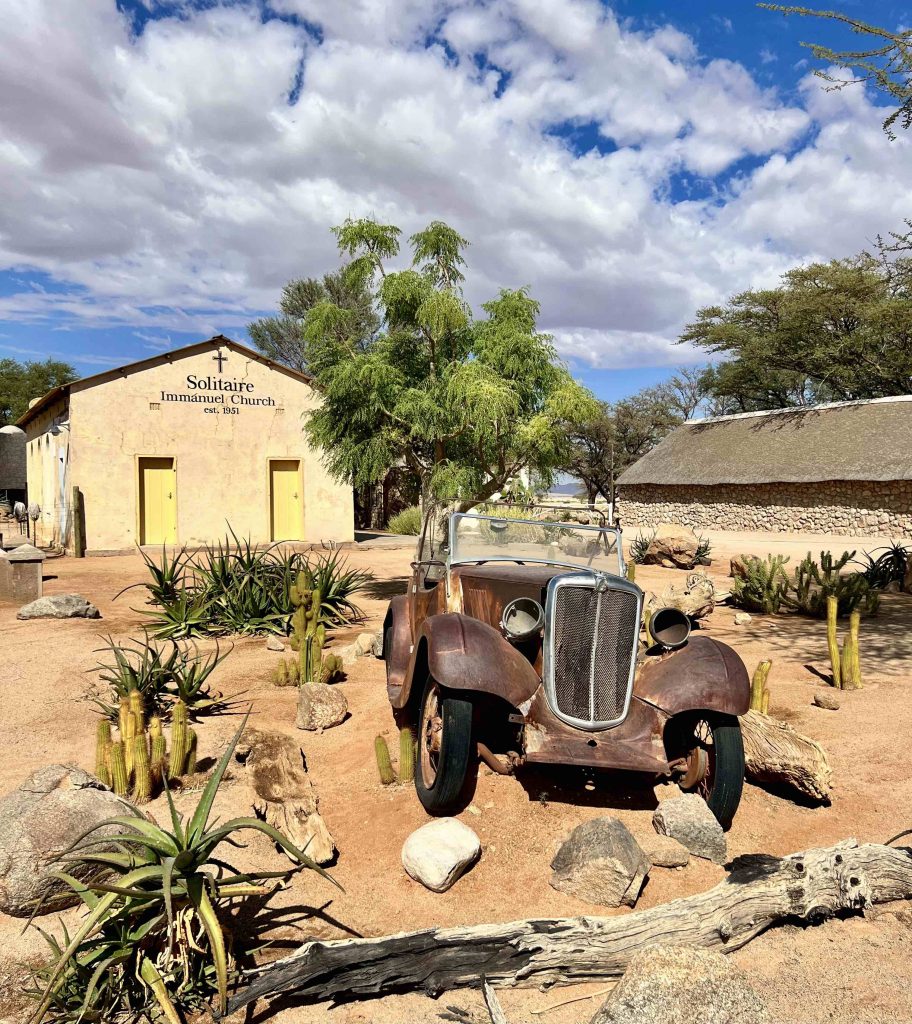
Another landmark not to miss is the Tropic of Capricorn, one of the five major circles of latitude marked on Earth maps. It marks exactly 23.5 degrees south, the southernmost latitude that experiences the sun directly overhead at noon. It is located on the road from Sossusvlei to Swakopmund (approximately one hour driving from Solitaire).
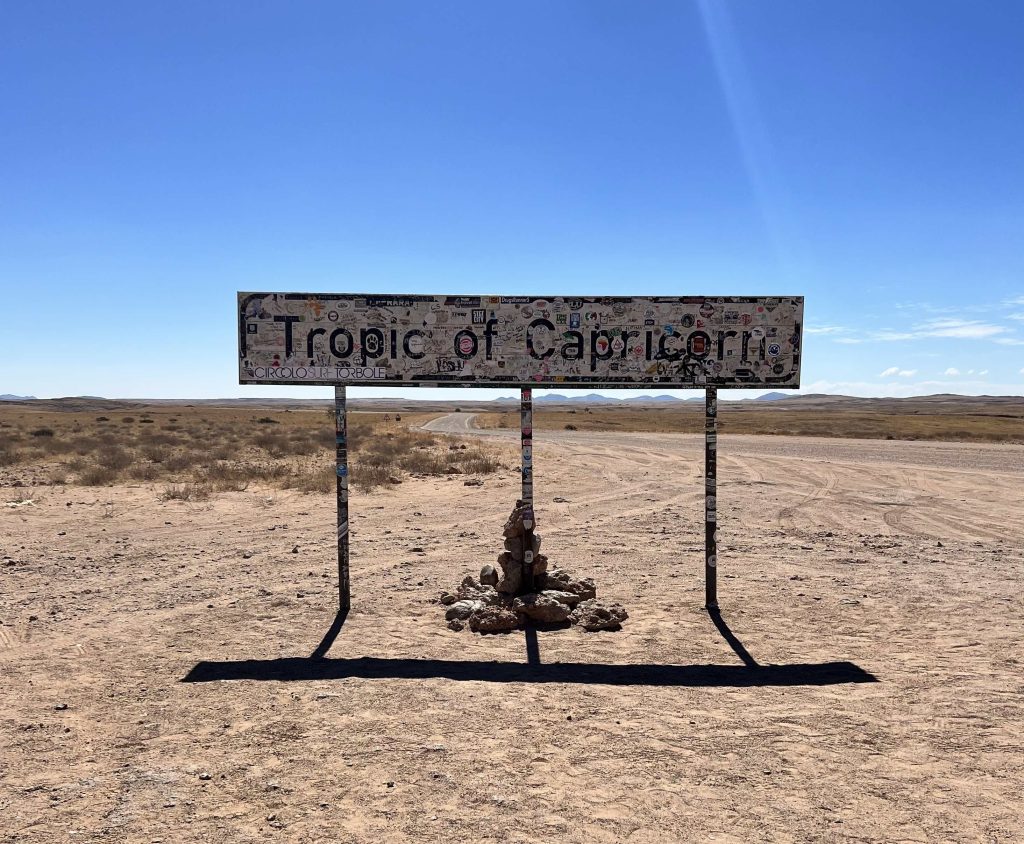
Climb Sand Dunes and Walk around Salt Pans in Sossusvlei and Deadvlei
Probably the most iconic attraction in Namibia, Sossusvlei and Deadvlei are a must visit place in the country. They are located in the Namib-Naukluft National Park, the largest conservation area in Namibia with more than 50 000km2.
This area is part of the famous Namib Desert, the oldest desert in the world, dating back at least 55 million years. It is also one of the driest places on Earth. In the local Nama language, Namib means “an area where there is nothing”. And when you are there, you can easily understand why, looking at the red dunes rolling endlessly into the infinite.
The emblematic dunes of this region were created by sand from the coast with more than 5 million years old, carried by the wind. In fact the wind blowing from all the directions, causes the sand to form a star shape of the dunes. That’s why those dunes are called “star dunes”. The reddish colour is due to the iron oxide.
Sossusvlei and Deadvlei are 60km far from Sesriem Gate, the entrance to the Namib-Naukluft Park. Most of the accommodation options are within a 1h drive from this gate, so I recommend to arrive to the park as early as possible in the morning. This will allow you to make the most of your time there, but also to avoid the warmest hours. If you are not driving, you can easily book a tour in most of the lodges. The tours usually start very early, in order to watch the sunrise already in the way to the park, which is an unforgettable experience.
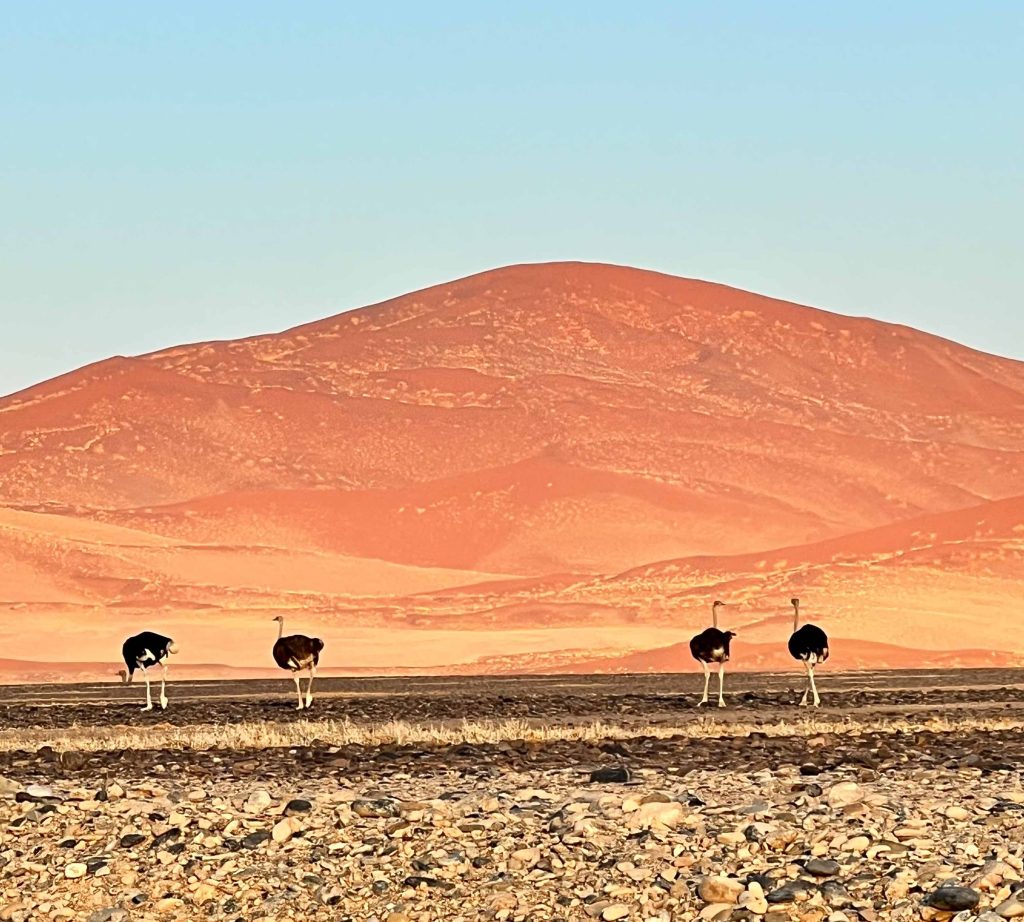
When you finally arrive to the park, you will be amazed by the unique landscape, framed by some of the highest sand dunes in the world. Dune 45 is one of them. This star dune name is due to the fact that it is situated 45km from Sesriem Gate and it is easily reachable with a 2×4 vehicle. Its accessibility and the amazing shape, makes it one of the most photographed sand dunes and an iconic landmark of Namibia. You can climb Dune 45, which is approximately 85 meters high.
But the highlights of this area are undoubtedly Sossusvlei and Deadvlei, two salt pans between the giant dunes. Deadvlei is the perfect postcard of the country. And probably the reason why I felt in love with Namibia many years before I visited it.
This white clay pan is famous by the petrified trees, that are estimated to be approximately 900 years old. They do not decompose due to the dry climate and lack of moisture in the air. Deadvlei entices visitors by its desolated scenery and the beauty of the white pans contrasting with the grey petrified trees and the reddish dunes behind it.
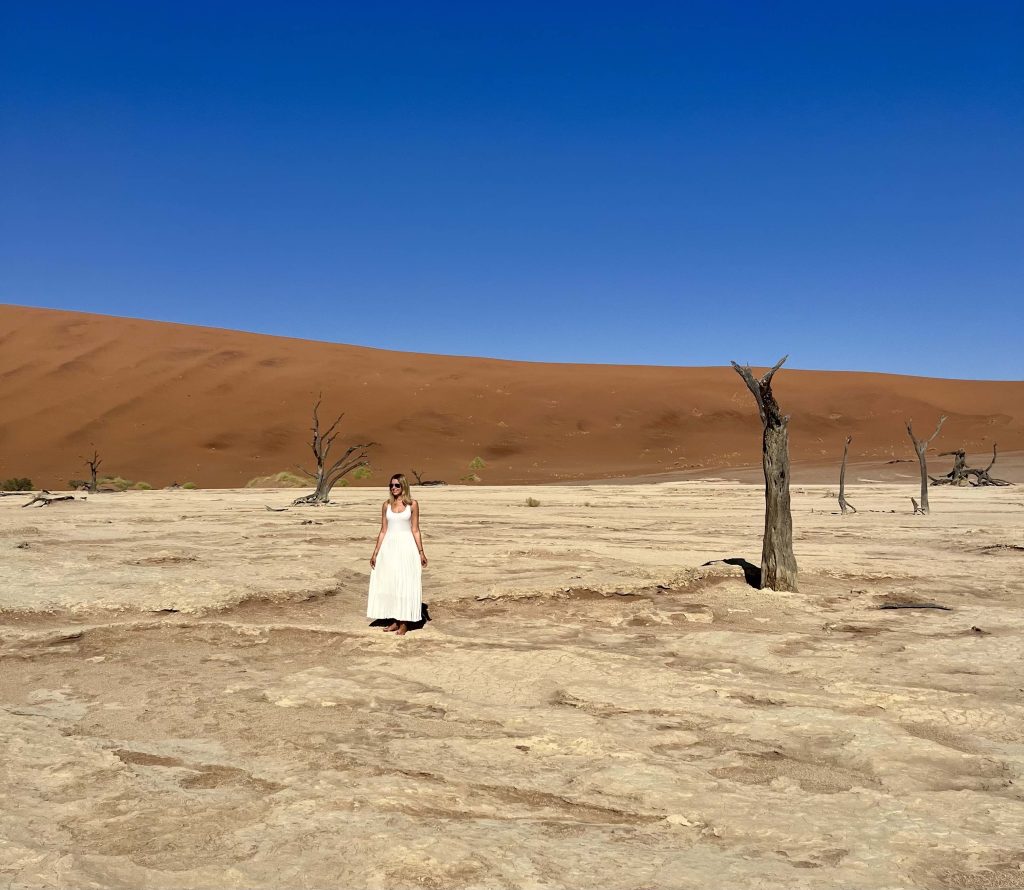
You can access Deadvlei walking directly there or through Big Daddy, the tallest dune in this area with 325 meters. In fact, climbing Big Daddy is an amazing experience while in this region. But be aware that the hike up takes around one hour and a half and it’s not an easy one. You keep slipping back in the soft sand over and over again, so it requires some resilience.
If you are brave enough to do it, take some water with you, don’t forget sun protector and try to go as early as possible to avoid the heat hours. It will be tough, but you will be rewarded by a fulfilling feeling of achievement. And you will experience the most incredible views to the endless surrounding desert and the Deadvlei far below you. At any moment of the climb, if you feel too exhausted, you can just drop down through the dunes until Deadvlei. It might look a bit scary when you are at more than 300 meters high, but trust me… it’s way easier than climbing the dunes and it gives you direct access to Deadvlei.
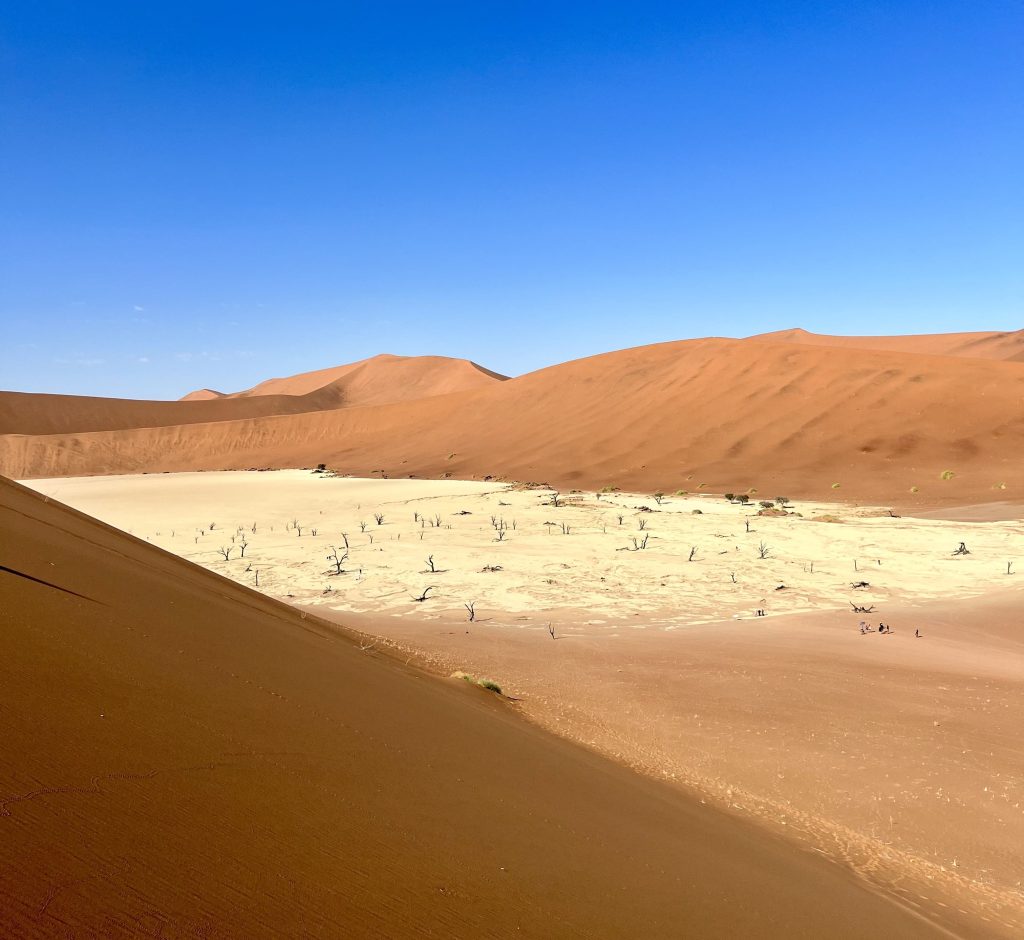
Big Daddy faces another very high dune known as Big Mama, which is also possible to climb.
If you have enough time, go to Sesriem Canyon, 4.5km far from the park entrance gate. You can have a walk through this impressive canyon, that has been shaped by the Tsauchab River over millions of years.
Experience a Sundowner Drive in the Namib Desert
If sunrises are amazing in the Namib Desert, sunsets are majestic and a not to miss experience while in this area.
Landscapes in the Namib Desert are breathtaking and even in this desert area, it’s possible to find over 3500 species of plants. The region is also characterised by its rich wildlife with animals like oryxes (considered the national symbol of Namibia), wildebeest, jackals or wild desert horses.
I had the opportunity to do a sundowner drive while staying at The Desert Grace, a beautiful lodge from Gondwana Collection Namibia. This lodge was entirely constructed using sandbags instead of brick, merging perfectly with the surrounding environment. Inspired by Wes Anderson’s films from the 60’s, the lodge brings you back to the charming atmosphere of the past, whilst presenting a great modern design.
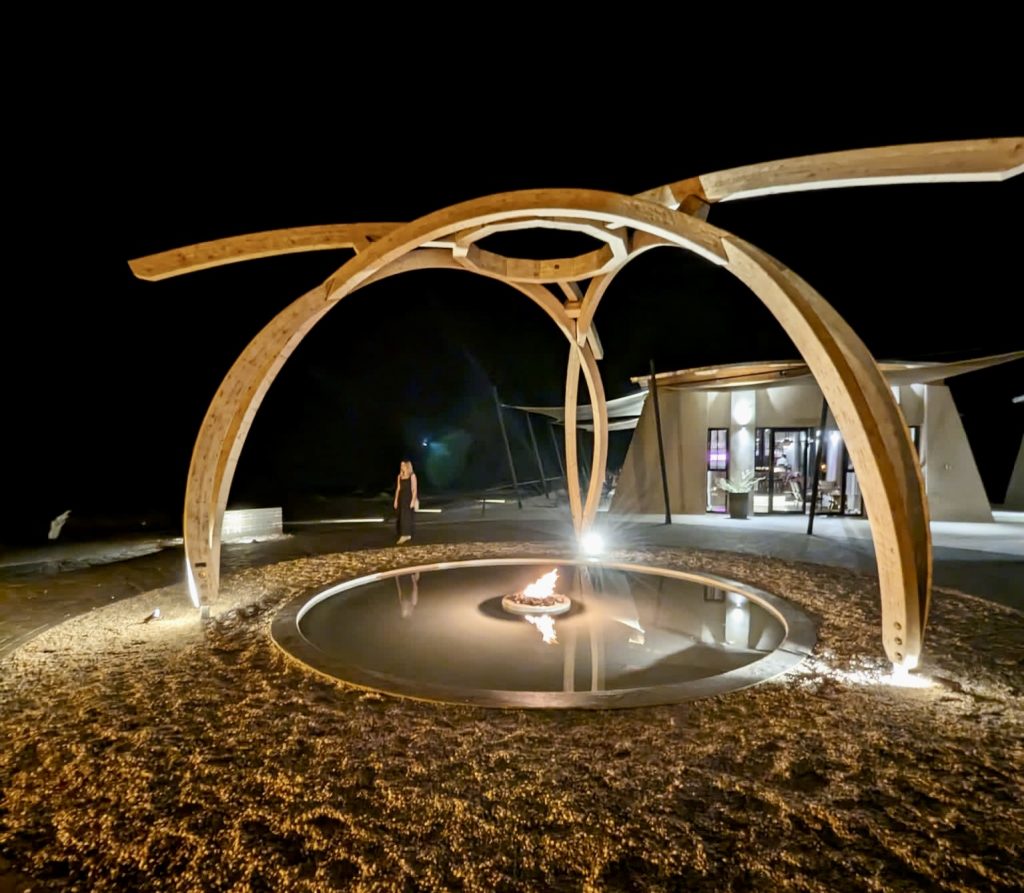
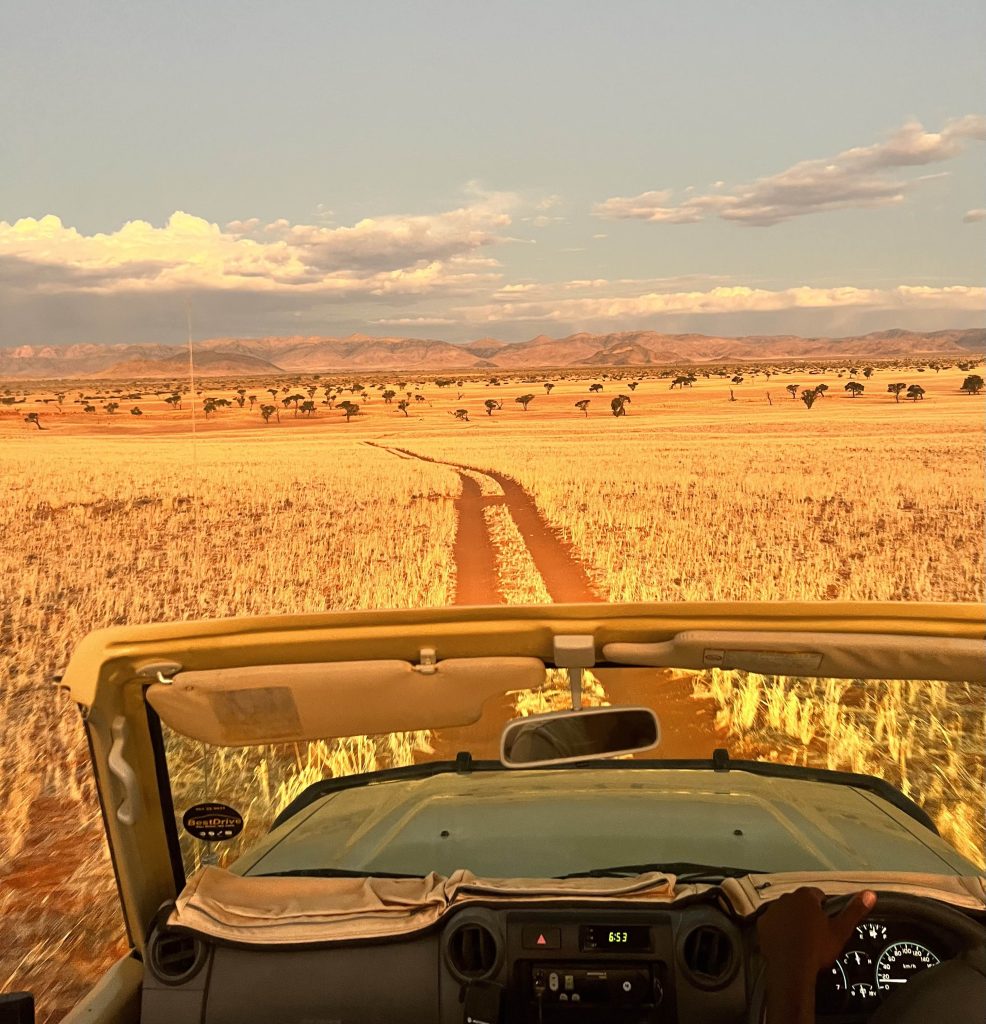
The sundowner drive was organized by The Desert Grace and it was one of the most unforgettable experiences in Namibia.
The drive started around 5pm, a couple of hours before the sun goes down at that time of the year in April. This gave us the opportunity to drive around the magnificent desert scenery, to find many desert animals and to discover the mysterious fairy circles. Those fairy circles are circular patches, mostly barren of grass, that science has not been able to explain its creation.
At the some point, we saw an oryx running in the middle of the Namib desert just near our 4×4 and I had to pinch myself, because I thought I might be dreaming. I was living a scene I had only seen in the movies so far.
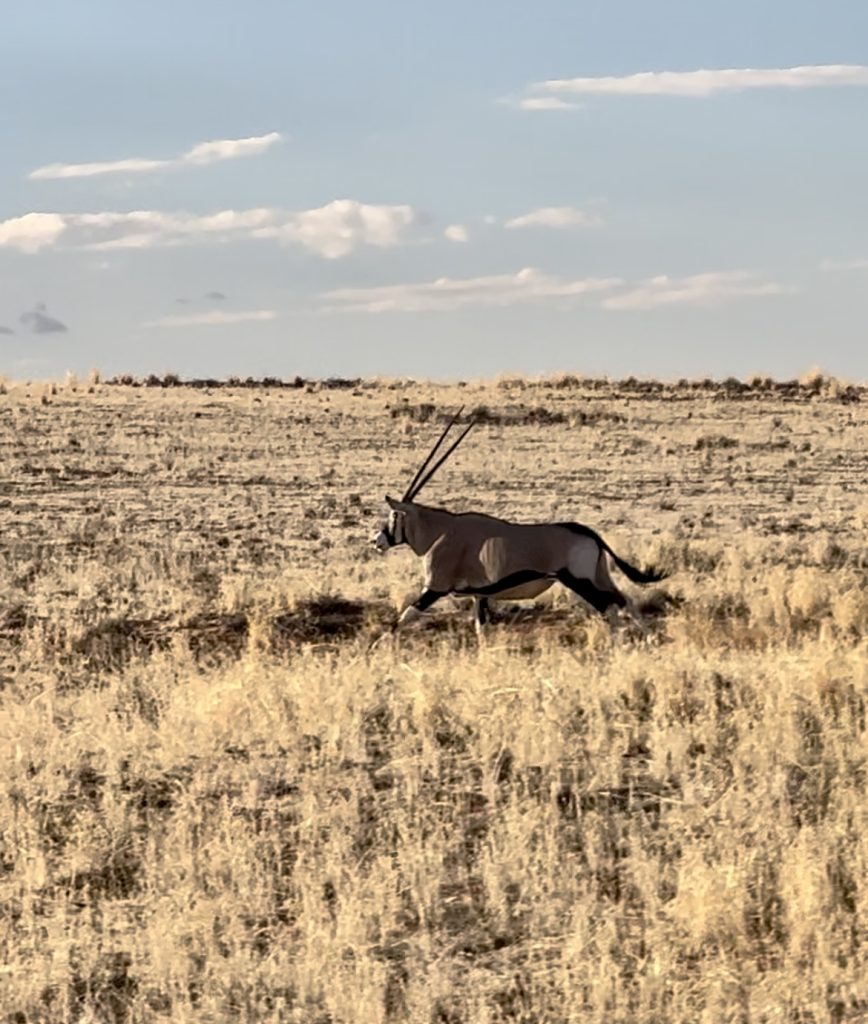
Before the sunset, our 4×4 stopped in a strategic location at the top of a hill with incredible views to the vastness of the desert for some snacks and drinks.
The colours of the Namib Desert are unreal and not comparable to anything I’ve seen before (even if I already explored other deserts). The sands get a vivid orange tonality, almost reddish, which makes it absolutely unique.
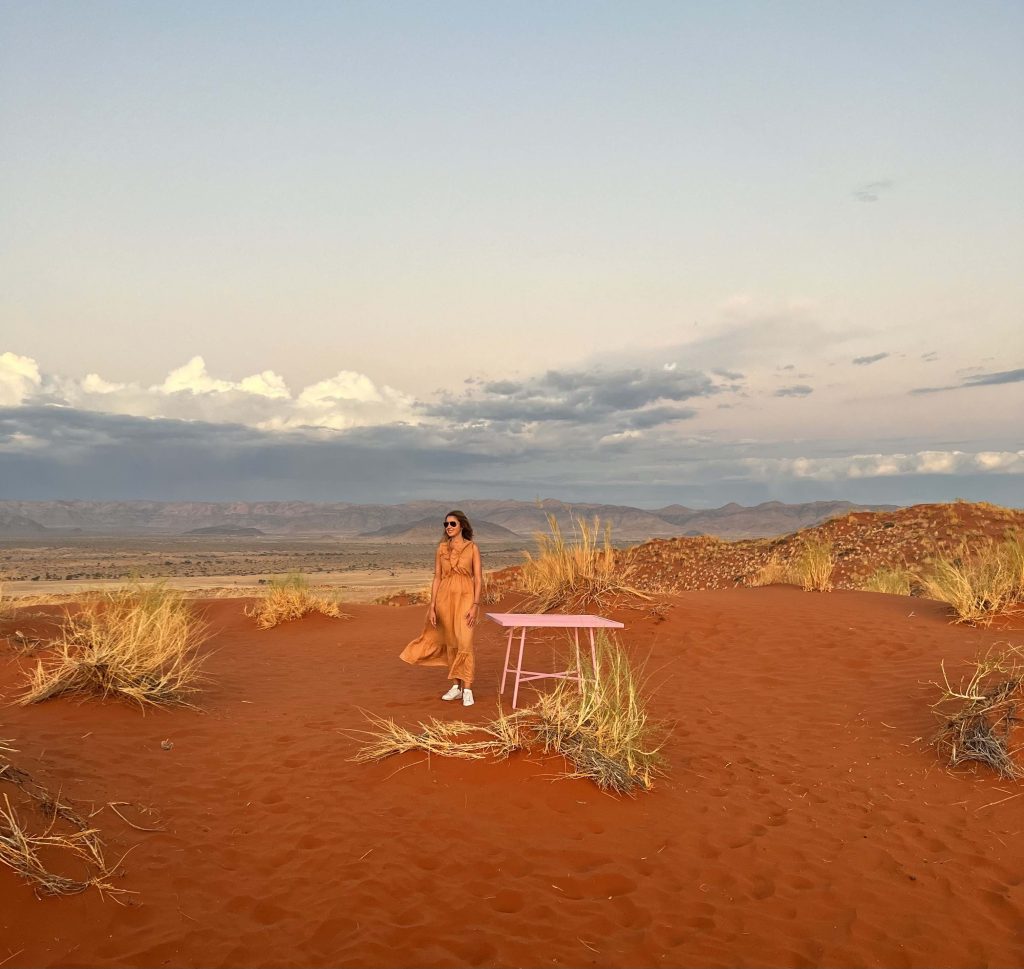
Stay in a Remote and Unique Retreat in the Desert
I’ve stayed in many beautiful hotels and accommodations around the world, but if I had to select the most memorable one, it would be Desert Whisper from Gondwana Collection Namibia.
Located in a remote location in the Namib Desert, miles away from any other inhabited place, Desert Whisper is more than a desert accommodation. It is an unforgettable experience! Imagine an exclusive and exquisite pod with a personal plunge pool and breathtaking views to the Naukluft Mountains and the vastness of the desert. It looks like a dream, but it’s real and you can find it in the Desert Whisper.
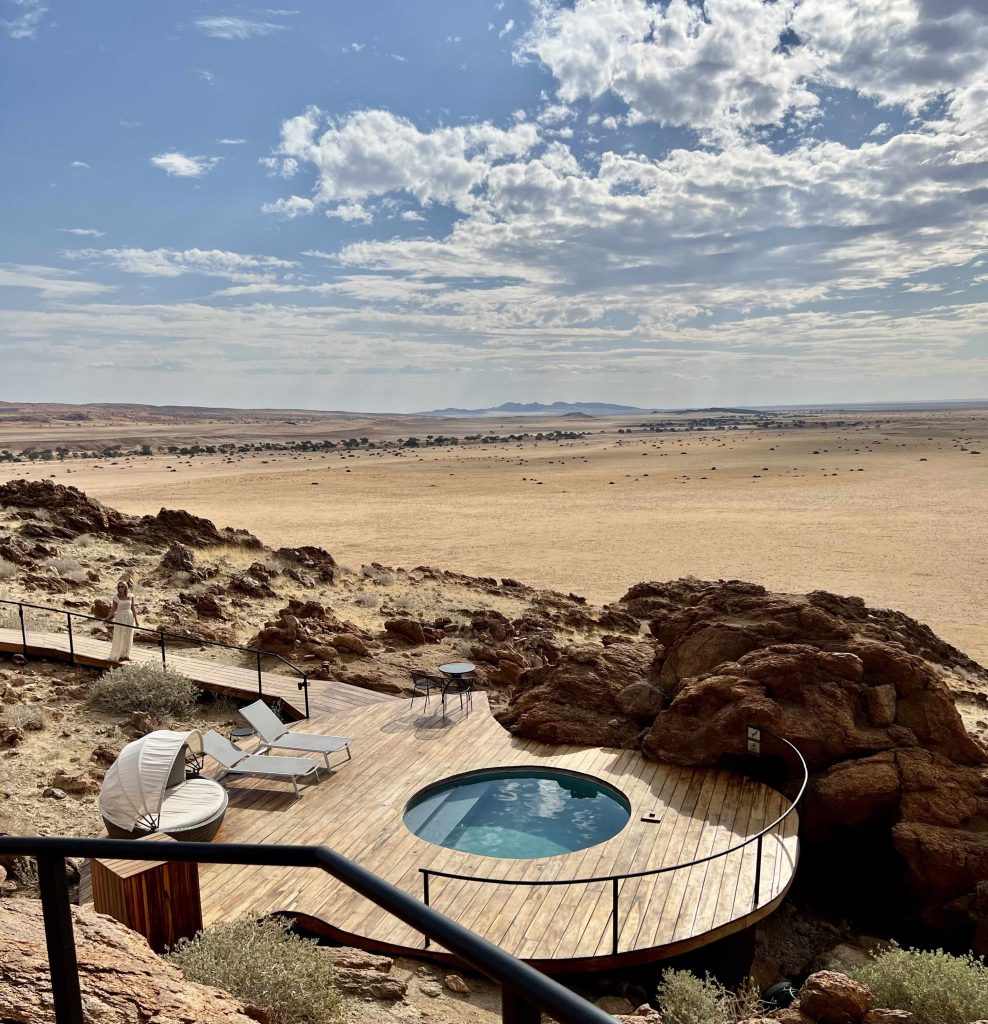
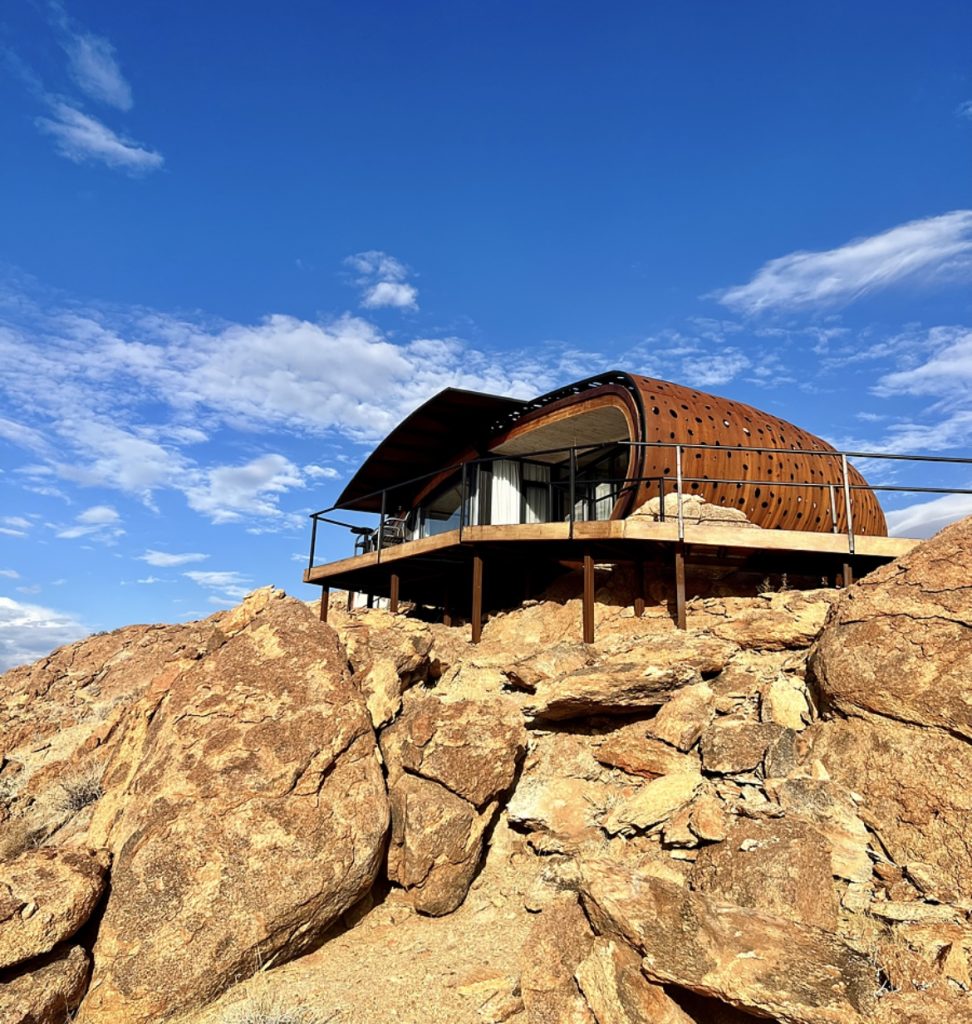
The concept of this luxury desert retreat is quite unique. A design pod inspired by nature and natural shapes that merges perfectly with the surrounding environment. And you have the accommodation all for yourself, with a fully equipped kitchen and a well-stocked bar.
I had some of the most memorable moments ever in the Desert Whisper. Sitting at the pool deck and watching an unforgettable sunset over the Namib Desert, is an experience that I will forever treasure. Or waking up early in the morning to see the sunrise from the glass windows of the bedroom, and being rewarded by the nature spectacle of an oryx running over the plain.
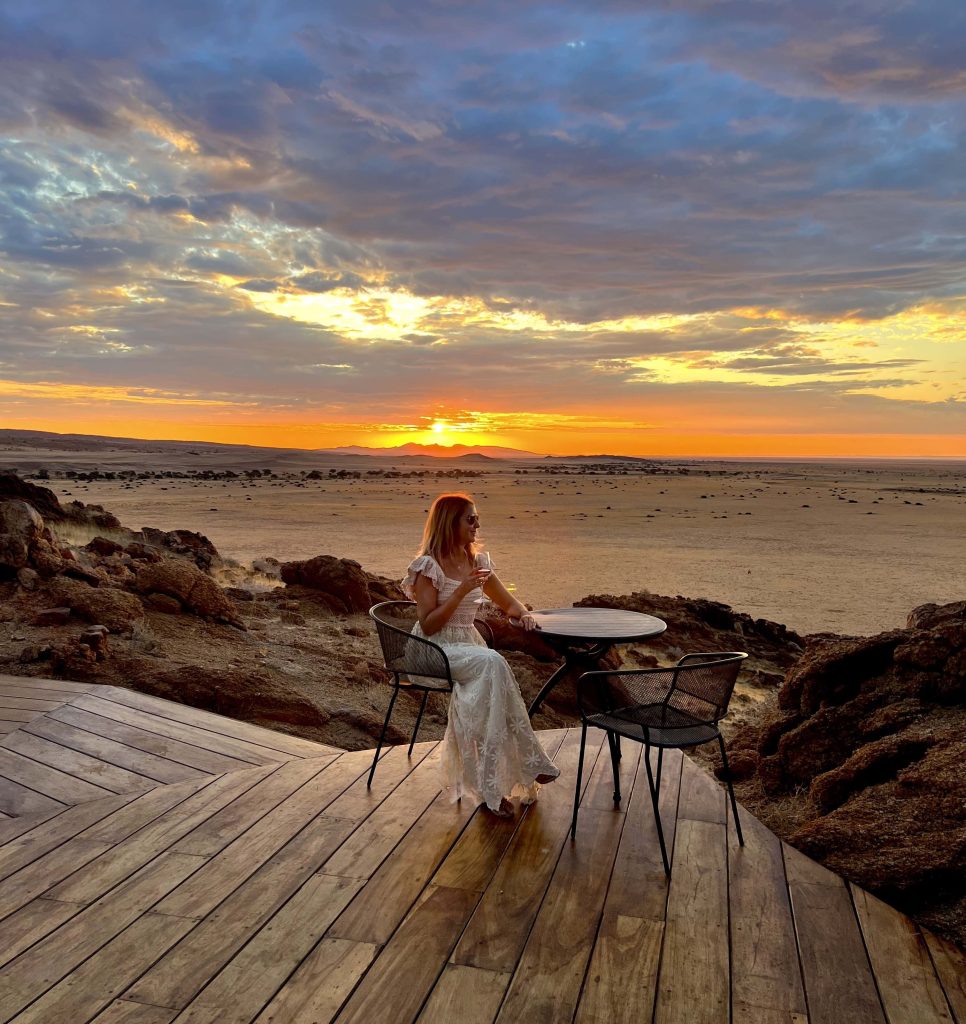
Walk around the Coastal Town of Swakopmund
After several desert exploration days, it was also great to arrive to Swakopmund, a lively and colourful coastal town which preserves a certain atmosphere from the past. It is also the starting point to visit the famous areas of Walvis Bay, Sandwich Harbour or Cape Cross, one of the world’s largest seal colonies.
In Swakopmund I stayed at The Delight Swakopmund, a stylish and comfortable boutique hotel in a perfect location to explore the city.
And definitely take some time to walk around Swakopmund and enjoy its great vibe. It was once a German colony and it is still visible the German influence in the architecture and culture of the city. Sometimes you almost think you are walking around a city in Germany.
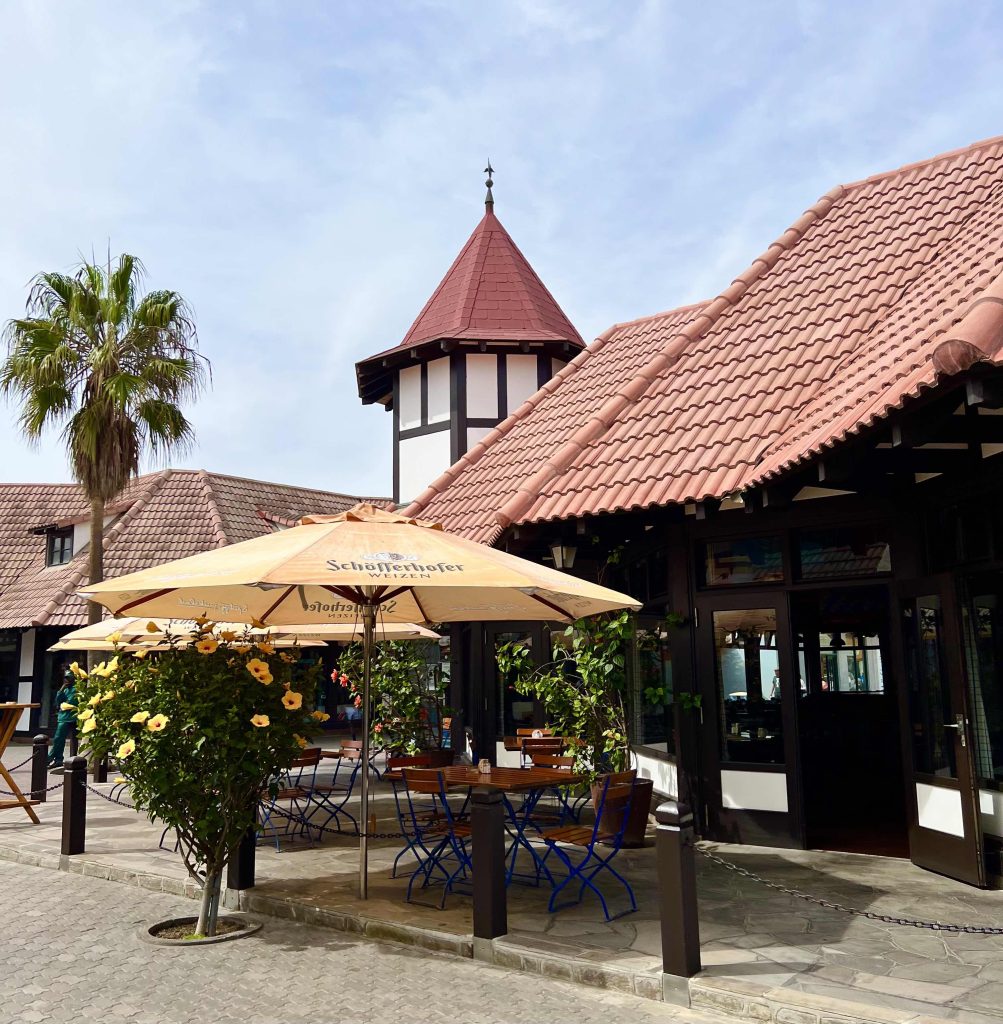
Many buildings had been restored and they look brand new. One of the most iconic is Woermanhaus, built in 1905. It originally belonged to a German trading company, but it is now a library and an art gallery. The city centre is very picturesque with a colonial style. It has restaurants, coffees and shops where you can buy local handcraft and souvenirs.
Don’t miss the famous Swakopmund Jetty, a pier with more than 100 years with excellent views to the ocean and the urban beach (called the Mole). In this area there are many options of restaurants with terraces facing the sea, where you can taste typical cuisine and the fresh local fish and seafood.
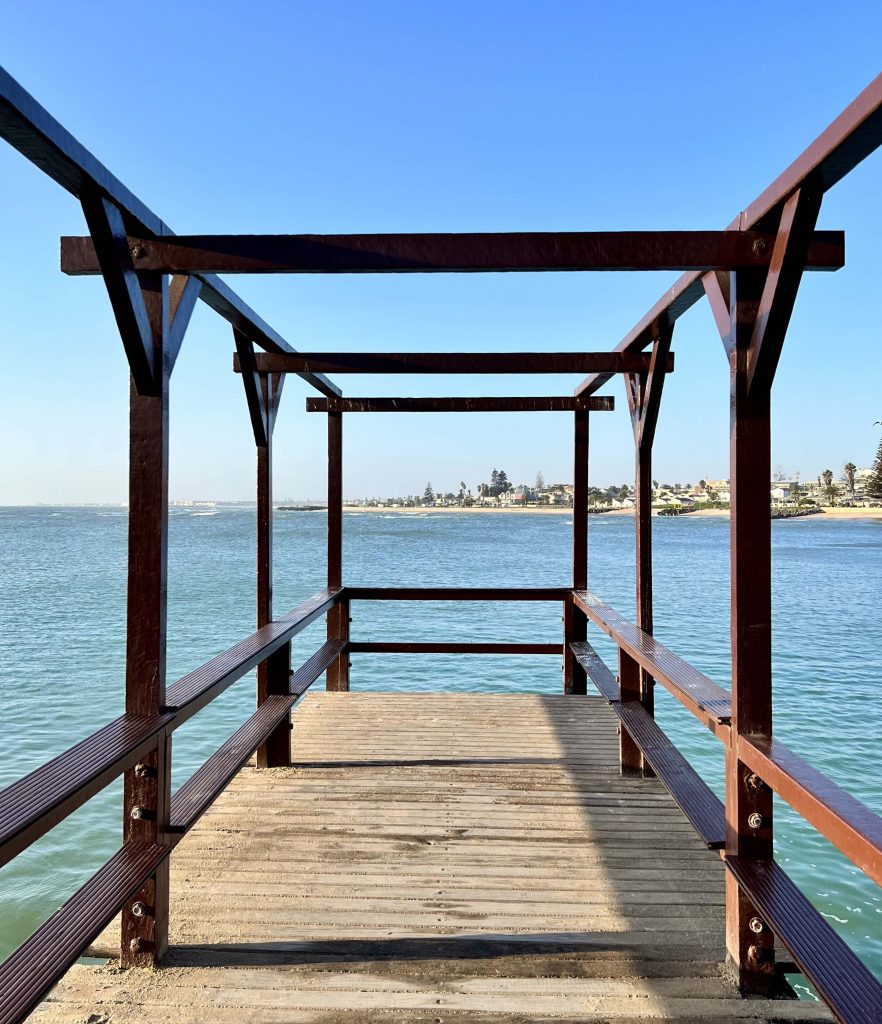
Another landmark of the city is the Lighthouse, built in the beginning of the 20th century. With 20 meters high, its light can be seen more than 33km out in the sea. So the lighthouse played an important role marking the harbour and warning ships off the threats of the Skeleton Coast nearby, where hundreds of broken ships litter today in its wild beaches.
You can also visit Swakopmund Museum, the largest private collection museum in the country, or the National Marine Aquarium of Namibia.
Watch Flamingos in Walvis Bay
Located near Swakopmund, on the way to Sandwich Harbour Sand Dunes, Walvis Bay is another great location to explore in this coastal region of Namibia. It is also one of most important tourist centers in the country.
Walvis Bay is the biggest harbour in Namibia, so with no surprise one of the most famous activities is to do a boat trip along the coast. Viewing dolphins or seals is often guaranteed (sometimes even whales) and many times the seals jump into the boat. There are also huge salt fields around the city.
But Walvis Bay is mostly known as a birds viewing location, where you can find more than 50 species of birds. It is considered one of the richest wetlands in Southern Africa and one of the best flamingo viewing locations in the world. You can find the greater and lesser flamingos on the shorelines, sometimes thousands of them.
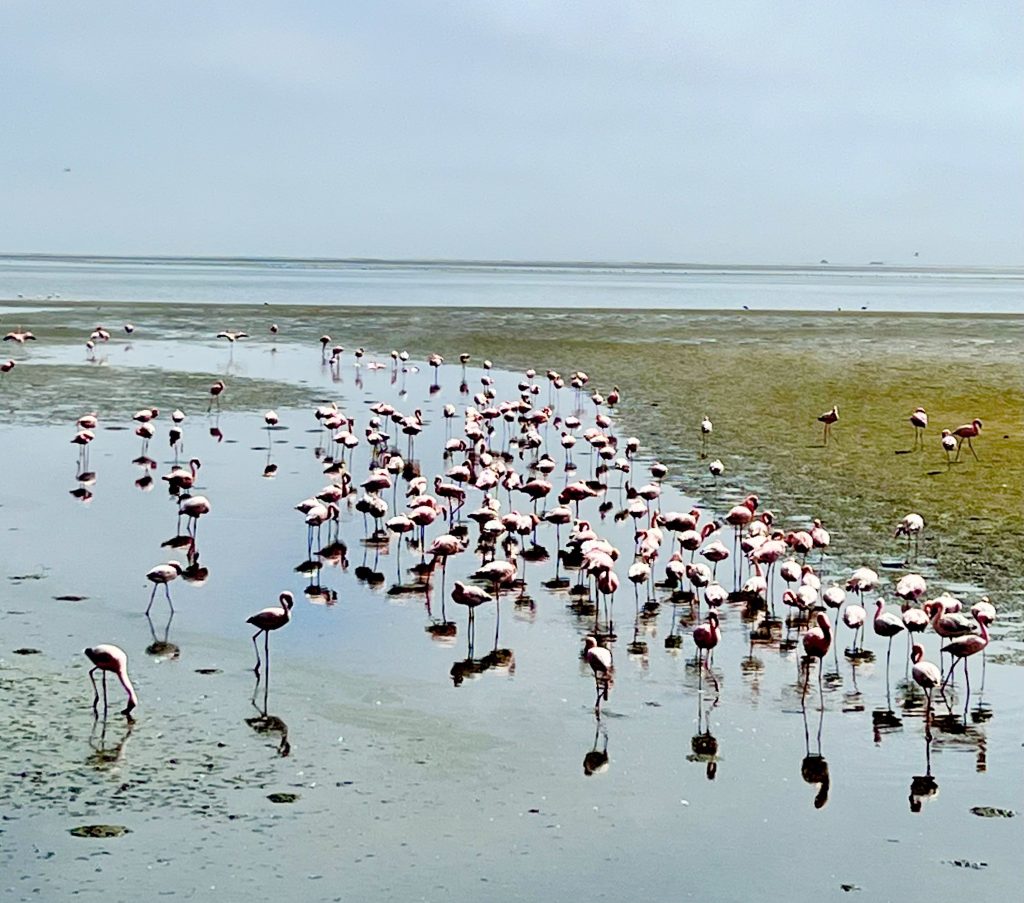
Take a 4x4 Drive in the Giant Dunes of Sandwich Harbour
Stretched along Namibia’s Atlantic Coast, the giant dunes of Namib Desert rolls down endlessly into the ocean in Sandwich Harbour. This is one of the most dramatic sites in Namibia and definitely one of the highlights of my trip.
Sandwich Harbour, which is also part of Namib-Naukluft National Park, is located around 60km south of Walvis Bay. The best way to explore this area is to take a scenic 4×4 drive. I booked my tour with Sandwich Harbour tour operator and I had a great time.
This adventure starts at Walvis Bay, with a stop at the lagoon to see the famous flamingos. During the drive, we pass through some pink salt lakes. After that, we drive into Kuiseb river delta. Its unique ecosystem of fossilized riverbeds and sand dunes is home to a rich wildlife including jackals, oryx, brown hyenas or springboks.
Next stop is Sandwich Harbour Lagoon along the beach, considered one of the richest and most unique wetlands in Southern Africa. You can spot different bird species, dolphins, while seals and even whales.
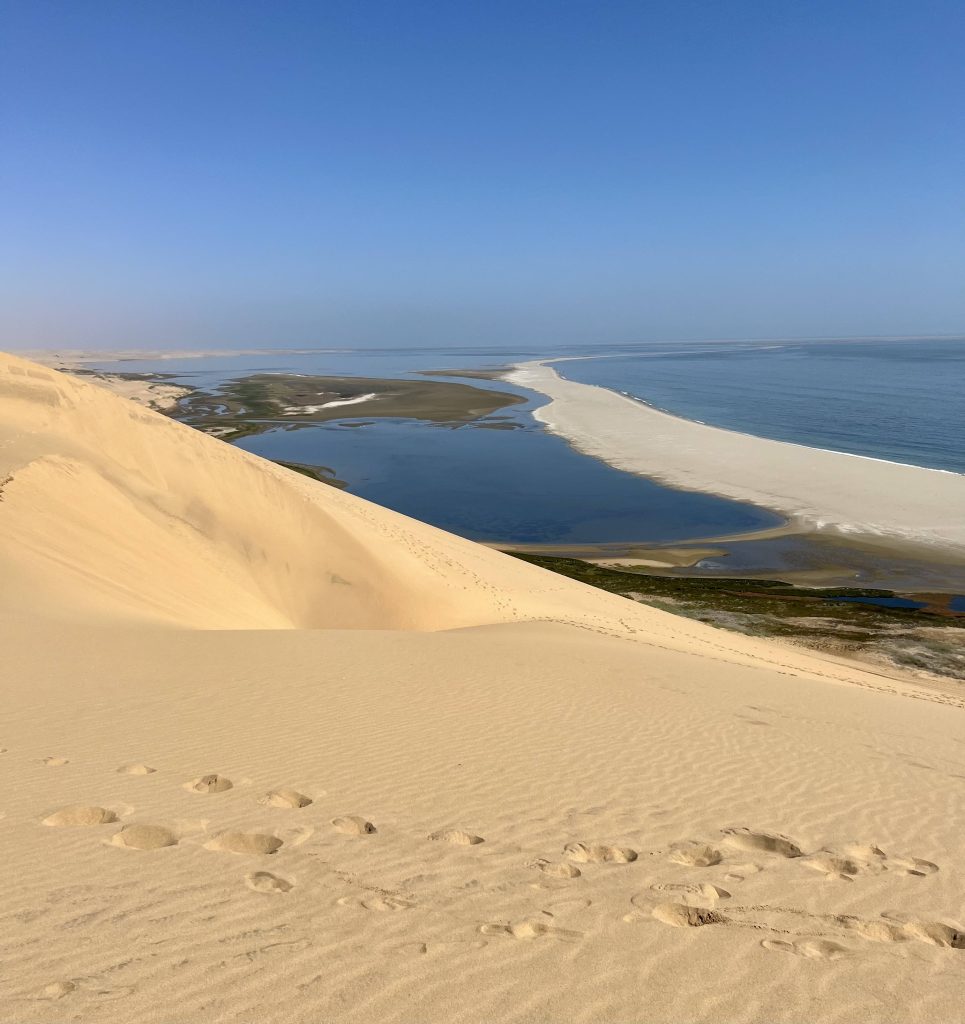
As the dunes become taller and steeper, you need to access Sandwich Harbour through the beach, in between the ocean and giant dunes. At hight tide, the waves submerge this narrow strip of sand, so experienced guides know perfectly how to navigate through the never ending shifting sands and the tides.
To get to the top of the dunes from where you have the most spectacular views of Sandwich Harbour, be ready for a thrilling adventure. And this is where the most exciting part of the journey is about to start. Your guide will take you in a 4×4 roller-coaster like drive though the highest sand dunes you’ve seen in your life. Your adrenaline levels will probably peak, but I assure you it’s completely worth it. When you get to the top of the dunes, the mesmerizing view of the giant dunes running straight into the Atlantic Ocean will leave you speechless.
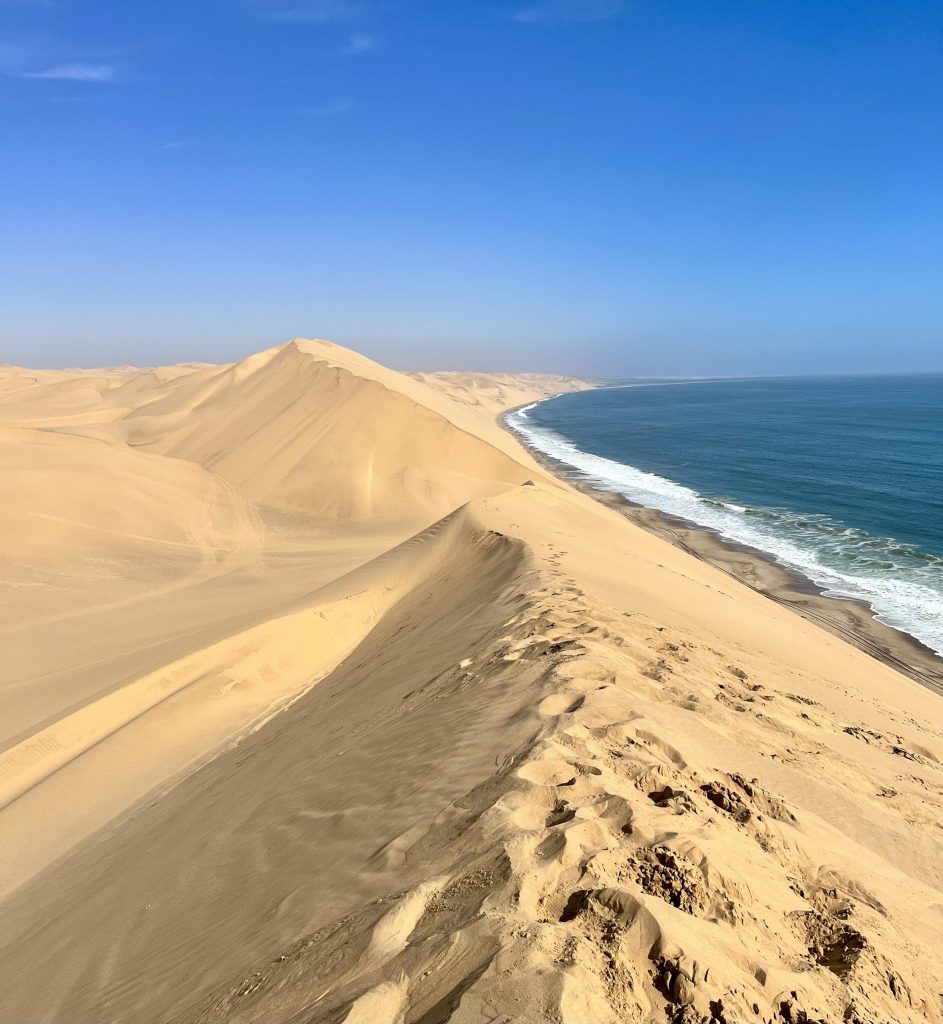
Before heading back to Walvis Bay on another exciting drive through the dunes, you will have time for one of the most memorable meals prepared by the driver. The famous oysters of the region, snacks and some sparkling wine, served at the top of a high dune overlooking the sea. It can hardly get better than that.
Go on a Safari
The most famous region for safaris in Namibia is Etosha, at the north of the country. In fact, Etosha is considered one of the best safari destinations in the world. It’s also where you have the best chances of seeing the Big Five (lion, leopard, rhino, elephant and African buffalo) in the country. So you should definitely add it to your Namibia itinerary.
In case you don’t have time to go to Etosha (that was my case), you can also have a safari experience around Windhoek. There are several conservation parks and game reserves in the surrounding area to the capital.
I stayed one night at Zannier Omaanda, a beautiful property located at half an hour from Windhoek, which is also a nature reserve with more than 7500 hectares and Owambo-style thatch and clay huts.
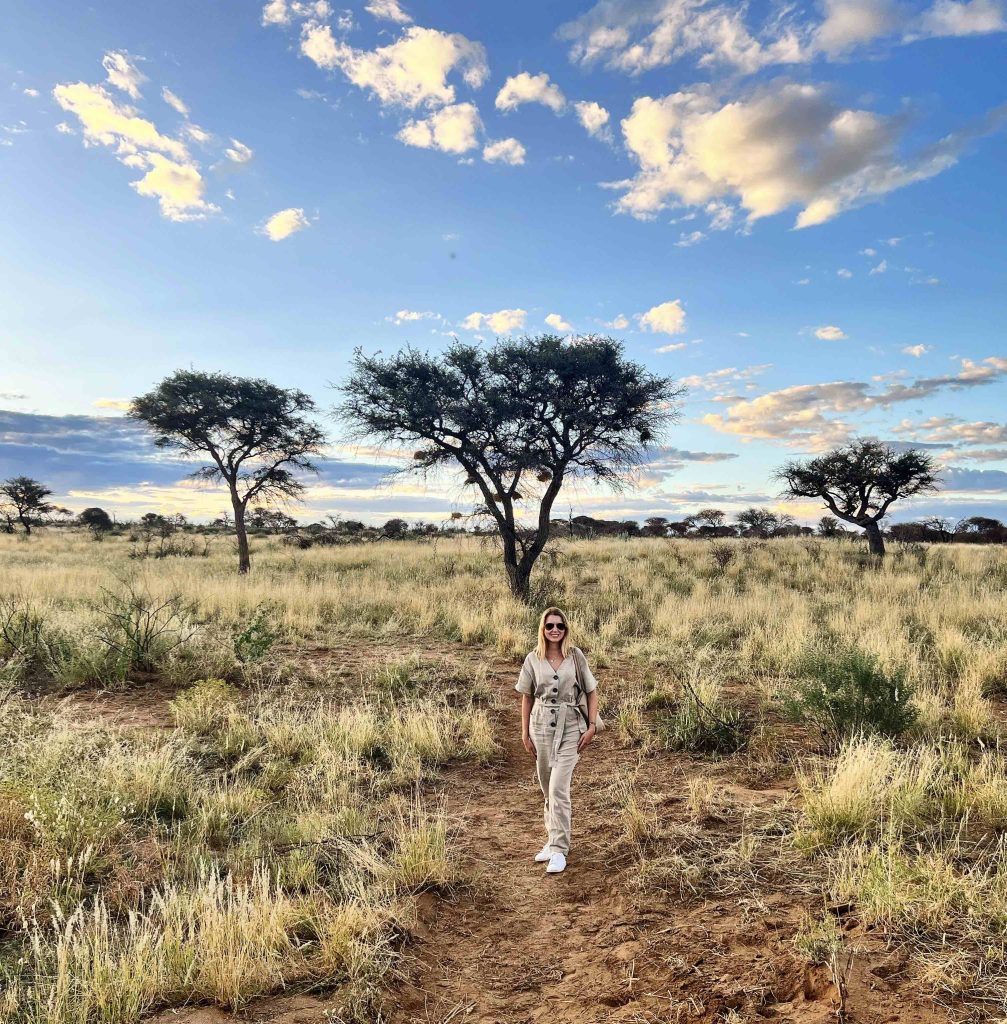
I did a conservation drive at sunset, which was an amazing way to see the diversity of species in the reserve.
There are no words to describe the experience of driving in an open 4×4 in the savanna. I had the opportunity to watch giraffes, antelopes, rhinos and lions. But in this conservation area there are also other animals like elephants or baboons.
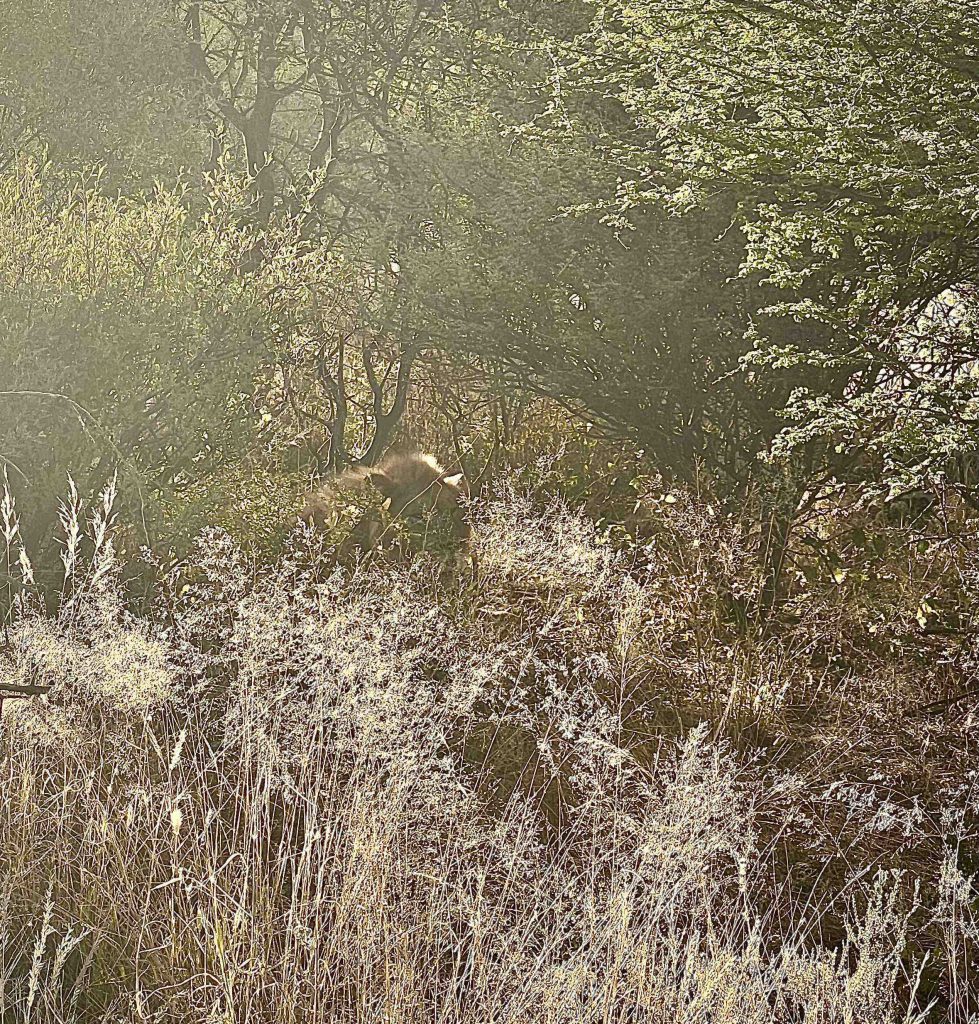
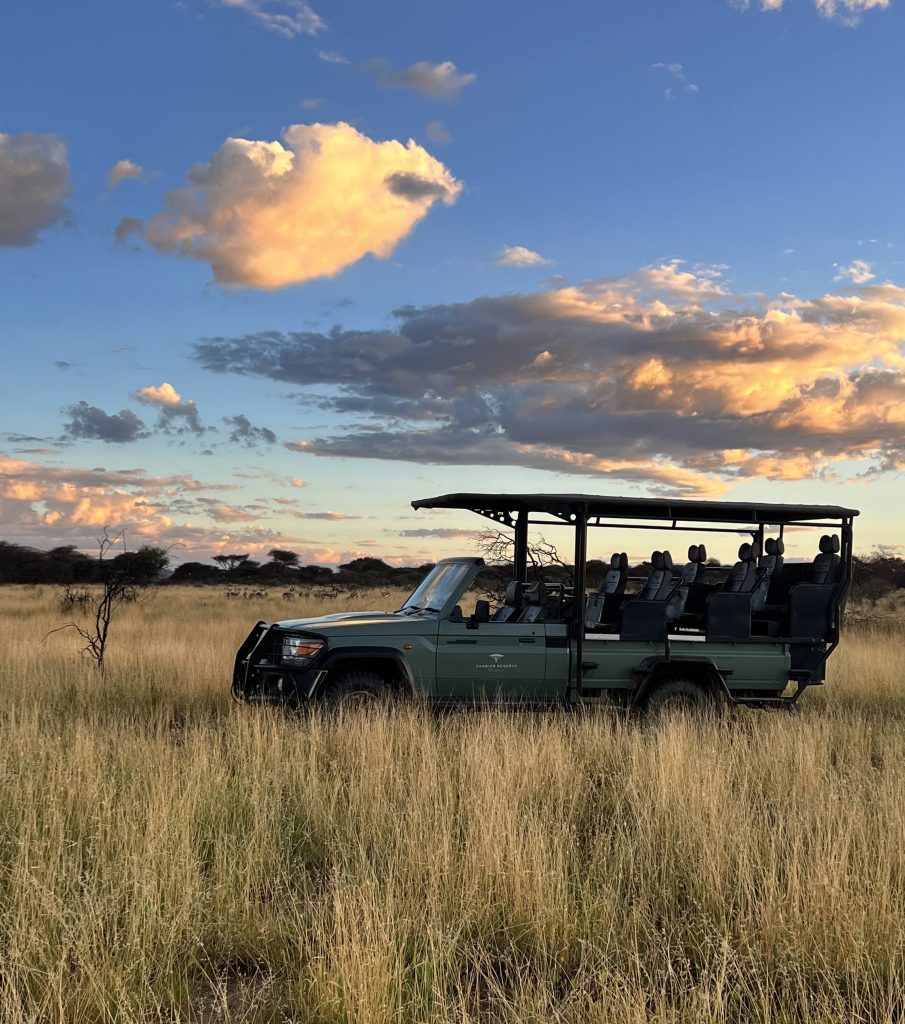
Have Breakfast with Giraffes
Did you know that you can have breakfast with giraffes and feed them in Namibia? This experience is available at Voigtland Guesthouse, a property established in the 1900s that combines the old world charm with a modern African decor. It is located into a hillside, with a magnificent mountain range as a backdrop and surrounded by gardens.
There are many activities available in Voigtland Guesthouse, from game drives, to quad biking, hiking or bird watching. But definitely the highlight at Voigtland is the amazing experience of giraffe feeding that you can combine with a breakfast or a high tea. I can assure that feeding the friendly Gustav giraffe and his friends is totally a bucket list moment.
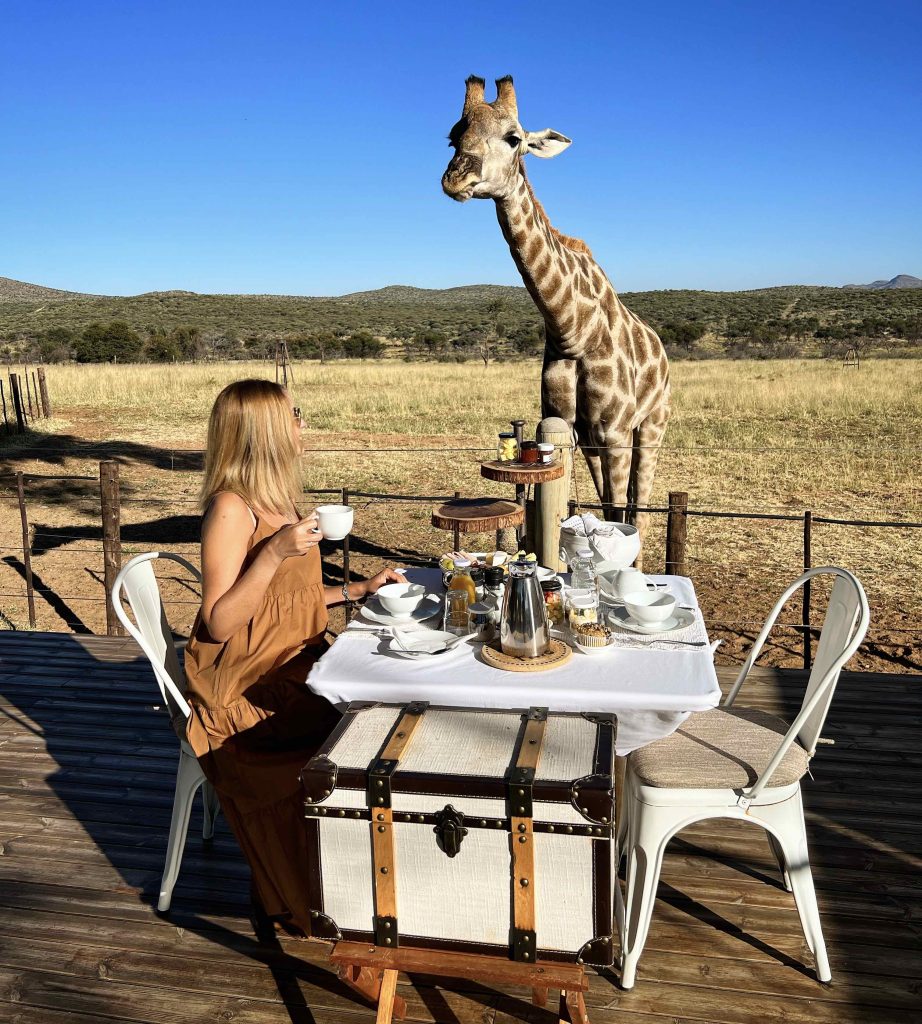
For more adventure travel inspiration, check my Jordan Travel Guide and Marrakech Travel Guide.


